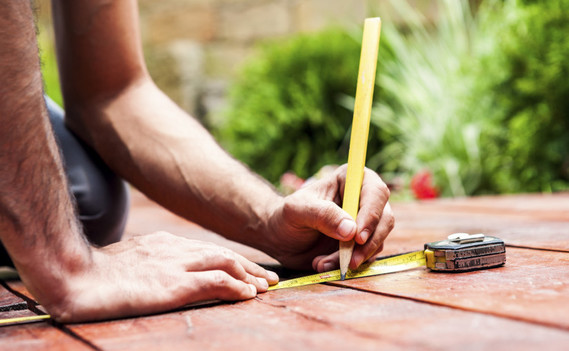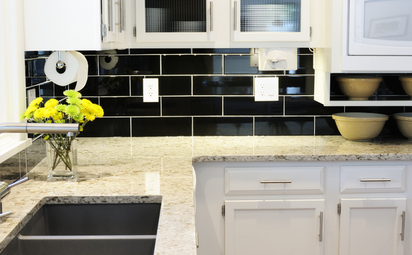|
Remodeling can cost thousands of dollars, which can take homeowners months or years to save.
– Photo courtesy of Modify Your Space In the interim, how do you make improvements to rooms like bathrooms and kitchens? Instead of taking out loans for an expensive remodel, consider investing in a few of these less expensive remodeling alternatives: 1. Refinish bathtub If you have a porcelain bathtub that looks a bit worn, the alternative to replacing it is refinishing the tub. While refinishing is a long process, it costs less than a new bathtub, about $300 to $1,000 according to ImproveNet. The process involves getting off all of the dirt and grime and then sanding it before putting on new layers of paint and primer. It’s a process that will leave your bathtub looking almost new if you have the right tools and want to invest at least a day working to refinish it. 2. Refinish wood floor Over time wood floors get scuffed, scratched and worn down by foot traffic in kitchens, living rooms and hallways. While homeowners might consider replacing parts or the whole wood floor, another option is to refinish the wood. The DIY approach is to sand down the wood floor and then re-stain it, which requires a lot of elbow grease and time to complete. If you want to have a flooring professional do the work, you might pay between $1,500 and $2,000 for wood floor refinishing depending on the square footage. 3. Replace cabinet and drawer hardware When cabinets are opened and closed continuously, the hardware can wear down, hinges may start to squeak and areas may crack. Instead of replacing the entire cabinet door, you can go to a local home improvement store and find knobs, hinges and pulls. Then on the weekend, using some screwdrivers and a drill, you can take off the old hardware and replace them so the cabinets have brand new knobs and hinges that don’t squeak. 4. Paint cabinets If paint starts to chip away from your kitchen or bathroom cabinets because of usage over time, you can take the doors off with a screwdriver and repaint them or have them professionally finished. This will save on having to replace the entire cabinet, and you can have them personalized for the room. If you choose to paint them yourself, be sure to choose quality paint that can last so you won’t have to go back and do it again. You also want to be sure and cover the hinges and knobs. It might be good to consult with a painter ahead of time just in case. 5. Update lighting For those who want to have a greener home, an inexpensive project is updating your lights from fluorescent or incandescent to LED. You can go to your local home improvement or big-box store and purchase LED bulbs for around $10 and install them in about any fixture. These will cut down on your utility bill while giving off the same glow without that bright, buzzing haze. You can also replace many of your hanging fixtures with recessed lighting, which can optimize ceiling space but might require an electrician’s expertise for handling exposed wires. 6. Paint appliances Many older homes have appliances that are oddly colored in pastels or pinks and blues. While these appliances are still in working order, they don’t match modern demand for stainless steel. Instead of replacing them, innovation now allows for homeowners to paint their appliances. Homeowners can buy painting kits to transform these retro appliances from old to new without spending thousands on all-new appliances. However, if you aren’t certain about doing it yourself, there are professionals who refinish appliances every day. These are just some of the inexpensive alternatives homeowners have to remodeling rooms in their home or ways to revitalize rooms while saving up for a remodel. If you need other ideas for updating without gutting a room, consider options like plumbing, furniture upholstery, heating and cooling and other small projects that will save you time and effort on a remodel.
1 Comment
An open house may be the best way to show potential buyers your listing. A house might look nice in a few photos but not so nice in person, or vice-versa. So how do you put on the kind of open house that is likely to leave you with an offer? Our Open House Checklist can show you what to do (and what not to do) to increase your chance of putting on the best and most successful open house.
What to do before the open house: You need to take your place from lived-in to open-house-ready. At a loss for where to start? Follow these suggestions!
Everyone has different preferences, but the following things may have an adverse effect on potential buyers. Avoid these mistakes when you’re planning your open house.
It can be easy to get lost and confused during the home buying process. Proper planning is paramount. It’s also helpful to learn from other people’s mistakes. Here are some of the most common errors people make when shopping for a new home.
Not budgeting for everything: Yes, this sounds obvious, but many people forget about some of the costs of buying a home. There are added costs such as furniture and appliances, DIY projects, moving fees, or your first mortgage payment. This last one is especially important—setting a budget may help you determine how much you can comfortably afford to pay for your mortgage. Neglecting your credit score: Your credit score will play a major role in the home buying process. This 3-digit number might be the thing that keeps you from your new home! Credit reports often contain errors or misinformation, so it’s important to retrieve your report ahead of time and fix any errors before sending it out to lenders. Looking at your credit reports may also give you a better idea of what interest rates you can expect so you can make room for them in your budget. Trusting verbal agreements: A home seller can verbally accept your bid and still turn around and give it to someone else if a higher bidder comes along. So before you celebrate your new home, make sure you’ve signed paperwork! Skipping the home inspection: You can’t expect the seller to tell you about all the potential problems you might face if you buy their home. There might even be issues with the house that the seller isn’t aware of, which is why it’s crucial to hire an inspector to take a look through the house. An inspector will examine the overall foundation and structural features of a house. It’s their job to find these areas of concern so that you don’t have to worry about them later on! (Tip: Don’t be too reliant on the inspector. You may catch these problems that they sometimes miss.) Sweating the small things: Don’t like the color of a house or the wallpaper inside? Is there something about the kitchen that you just can’t stand? Don’t sweat the small things! Focus instead on the location and the overall structure of the house. Once you move in you can change the small things you don’t like and make your house a home! If you avoid these mistakes and work closely with a CENTURY 21® Affiliated Sales Associate, you may just find the home you’ve been searching for! When you are in the process of buying or selling a home, there are a lot of tasks that need to be handled. It can seem overwhelming, but with the right tools, you can stay organized and on top of everything that needs to be done. Luckily, there’s an app for that. Use these apps to help stay productive and organized during the home buying and selling process.
|





 RSS Feed
RSS Feed
